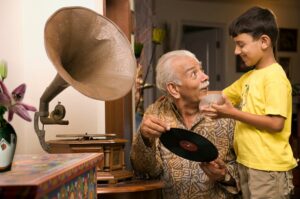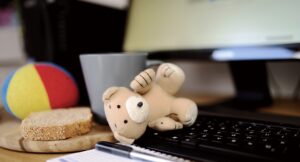Easter is the highest holiday in the Protestant Church. But Easter also has a meaning for non-Christians. Spring is here, nature is awakening and the days are getting longer again. To celebrate this, many Easter customs have been created over the centuries.
In this article you will find interesting facts about Easter, its meaning and many ideas to make your Easter celebration very personal.
Table of contents
Why Do We Actually Celebrate Easter?
Every year we celebrate Easter. But why? Because Easter is more than just painting Easter eggs. The date of this celebration is calculated according to the lunar calendar. Since Easter Sunday always falls on the first Sunday after the first full moon in the spring, the date for Easter fluctuates between March 22 and April 25 of each year.
Easter is a Christian holiday that commemorates the crucifixion and resurrection of Jesus Christ. Easter is preceded by a fasting period of 40 days, which ends with Maundy Thursday.
On this day, Jesus held the Last Supper with his disciples before he was arrested. The following Friday is known as Good Friday when Jesus was killed on the cross. Easter Saturday is also referred to as Holy Saturday and represents what is known as the rest in the grave. Easter Sunday is celebrated by Christians as the day of Jesus’ resurrection.
Easter And The Meaning Of Lent
Lent (Passiontide) is 40 days long, beginning on Ash Wednesday and ending on Maundy Thursday (formerly Holy Saturday). Sundays are not counted, as they are not considered fasting days.
Several times in the Bible, important periods are indicated that are connected with the number 40. The duration of Lent before Easter refers to the 40-day period of fasting and prayer that Jesus went through after his baptism in the Jordan River.
While in the Middle Ages virtually nothing was allowed to be eaten during this time, today only Ash Wednesday and Good Friday are considered fasting days. During this time, people are allowed to eat their fill once a day, although meat should not be on the menu.
The Passion period became longer and longer over the centuries. In the 2nd century, fasting lasted for two days. A century later, Lent lasted the entire week before Easter and was called Holy Week. In the 4th century, the quadrates is mentioned for the first time – a fasting period of 40 days.
Maundy Thursday: The End Of Lent
The word “green” in this context comes from “gronan” and means to weep (greinen). It is assumed that this refers to the tears of penitents who have been readmitted to the ecclesiastical community after the period of fasting and penance. This day marks the end of the Passion period.
On Holy Thursday, after the Catholic Mass, the altar is emptied. Everything remains without decoration and the organ and church bells must remain silent. Therefore, on this day, the faithful are not called to worship with the ringing of bells, but with wooden rattles or ratchets.
Good Friday – The Crucifixion Of Jesus Christ
In the Catholic Church, only a simple service is held on Good Friday, the day Jesus died. In the Protestant Church, on the other hand, it is the highest holiday in the entire year. Good Friday is derived from the Old German word “kara”, which means lamentation.
Holy Saturday: Rest In The Grave And Preparation For The Resurrection
Easter Saturday, also called Holy Saturday, is the day of the so-called grave rest for Christians. Symbolically, on this day everything had come to an end and hope for a Savior was lost.
The subsequent resurrection of Jesus is meant to illustrate that there is always hope and a turn for the better, no matter how hopeless and lost a situation looks at the moment. Underneath all visibility, fate is already turning for the better.
On Easter morning, the celebrations of the Resurrection begin. The bells ring again, Easter water is consecrated and Easter fires are lit everywhere.
Easter Customs Outside The Christian Tradition
After looking at what the traditional origin of Easter and its meaning are, let’s take a look at different Easter customs that have developed over the centuries. Every non-believing person associates Easter with the Easter bunny and the Easter egg.
In pre-Christian times, the egg stood for new life. A solid shell hides the chick until it makes its way into the world. Today’s custom of painting, hiding, and searching for Easter eggs can also be traced back to early Christianity.
During the last week before Easter, Christians were not allowed to eat eggs. Instead, they were collected and decorated to be consecrated on Easter Sunday and eaten as a symbol of new life. Today’s Easter egg hunt has evolved from this ritual.
Easter And The Meaning Of The Easter Bunny
If the egg is symbolic of the renewal of life – then how does the Easter Bunny fit into the picture? While the egg represents new beginnings, the bunny is a symbol of fertility and the onset of spring.
Hares can give birth to up to twenty young animals within a year and were first mentioned in connection with Easter in 1682. How Easter and the hare came to be associated is not clear.
According to a conjecture from the Middle Ages, it was customary to pay one’s debts in the spring (i.e. around Easter time). Those who could not settle them with money paid with eggs or hares.
Whether these explanations are true or not, Easter is the time for a wide variety of Easter traditions. These include:
- Easter bonfires.
- Easter wheels.
- Egg race.
- Easter horseback riding.
- Drawing Easter water.
- Bathing in Easter water.
- Easter water as a symbol of fertility.
- Sorbian Easter customs.
The Most Beautiful Easter Customs
Easter Fire
The Easter fire is a pagan ritual from the Middle Ages, with which the spring should be welcomed and the winter spirits should be scared away. In those times, spring, its warmer temperatures, and the blossoming of nature had greater existential significance than in modern times.
People were grateful that the days were getting longer again and the sun was shining more strongly. After the long period of cold, people and animals breathed a sigh of relief and looked forward to a time of abundance in nature.
Easter Wheels
Different Easter customs developed not only in different countries. Within Germany, there are Easter customs that have become established only in specific regions. Easter wheels, for example, are a variation of Easter bonfires and are made and rolled down a hill in Hesse, northern German communities and in some Austrian Alpine regions at Easter.
Large wooden wheels are used for this purpose, which is filled with straw. After this is lit, the wheels are let roll. In the Weserbergland region, the running of the Easter wheels followed by fireworks is one of the Easter customs that attracts a large audience every year, thus giving Easter a special meaning.
Egg Run In Different Ways
Egg run everyone knows from kindergarten or children’s birthday parties. An egg has to be balanced on a spoon over a distance. Whoever reaches the finish line first with his egg is the winner.
Some Easter traditions know the egg race in different variations. For example, as a pair competition in which one participant must try to collect as many laid eggs as possible while their partner must run to a designated point and return. The pair with the most eggs wins.
In some regions of Germany, the egg race is known as Eiertrudeln. This is not about speed, as the eggs are set rolling on a hill and trundle down the slope to be caught by children.
The goal of egg trundling is to let the Easter egg trundle to its destination as unharmed as possible. Unfortunately, in most cases the eggs are not edible afterwards.
Rare Easter Traditions Like Easter Riding
Those who celebrate Easter in the Spreewald know the custom of the Wendish Easter riding. With it, the message of the resurrection of Jesus Christ is proclaimed by riding through the Spreewald villages. Zerkwitz is the starting point of the procession.
The riders carry four Easter flags as well as a green cross, which symbolically proclaims salvation and peace. The Easter ride is followed by many passers-by along the streets, who receive so-called bouquets of hope made of boxwood from the riders.
The procession rides in silence through the villages. A stop is made in Klein Radden for the reading of the Gospel, prayers are said for all the people and hymns are sung. The next stop is in Ragow.
There a brass choir will sound and afterward refreshments will be provided. The last break of the 20 km long Easter ride takes place in Krimnitz. Who would like to participate in this Easter ride itself, is always welcome. Mitreitende must only have a horse and be at least 14 years old.
Easter And The Meaning Of Easter Water
Easter water is water from a spring or stream that is drawn on Easter morning. Various Easter customs revolve around this water. Those who bathe in a flowing brook on Easter morning receive youth and beauty and are spared from illness and sorrow.
The Easter water is also considered to promote fertility. For this purpose, young girls must draw the water against the direction of flow on Easter morning and silently bring it home so that the healing power of the water can take effect. If even a drop is spilled on the way, the journey was in vain.
The Easter water also plays a crucial role in baptisms. Anyone who follows baptisms in royal houses knows that most children are baptized around Easter, regardless of their date of birth.
Some royal offspring are only a few weeks old at this time, while others are already several months old. Here, Easter is given special significance and the baptismal water also plays an important role.
Sorbian Easter Customs
The Sorbs are located in the Spreewald region of eastern Germany and are known for their beautifully painted Easter eggs. The eggs are not painted with colors, but decorated and colored with wax. Wax and scratch techniques are used to create unique pieces that are one of a kind.
If you want to practice these techniques yourself, you just need a little patience and practice. For the first attempts, the so-called bossing technique is recommended. Here, the eggs are not dyed, but only decorated with wax.
The batik technique, which is also called the wax reserve technique, is also suitable for beginners. In addition to wax painting, only one color is used here. The patterns on the Sorbian Easter eggs are composed of many symbols, each of which has its own meaning. These include a bee cell, which consists of six honeycombs.
The sun and bundles of rays are represented as strokes drawn with the head of a pin. Triangles strung together form wolf’s teeth, representing protection from evil. Pine branches are depicted with dashes arranged in two and signify good health.
Easter Customs In Other Countries
Among Finns, acquaintances and family members are lightly beaten with a birch rod. This is said to be reminiscent of Jesus’ entry into Jerusalem, which was received with palm branches.
But there are also Easter traditions that are celebrated in an exuberant and joyful way. In Mexico, for example, people celebrate Easter with a folk festival that lasts two weeks and during which all the streets are colorfully decorated.
In Bulgaria, Easter is also celebrated with Easter eggs. On Easter Sunday, after going to church, people “duel” with eggs. This means that two eggs are beaten together with their tips. The egg that survives and still has its shell intact at the end wins and gives its owner a particularly happy year.
Why Does Easter Have A Meaning For Us?
So to the question, Why do we celebrate Easter? there are two answers. Because it is a Christian holiday in its roots, and because over time Easter customs have developed that are based on the timing of Easter and welcome the awakening of nature.
As a result, Easter has been able to retain its significance even among non-Christians to the present day. Christian Easter celebrations and non-Christian Easter customs nevertheless have something in common – both views are about life.
About a new beginning. When new life awakens, this beginning always stands for something better. It gives hope, courage and the prospect of growth.









